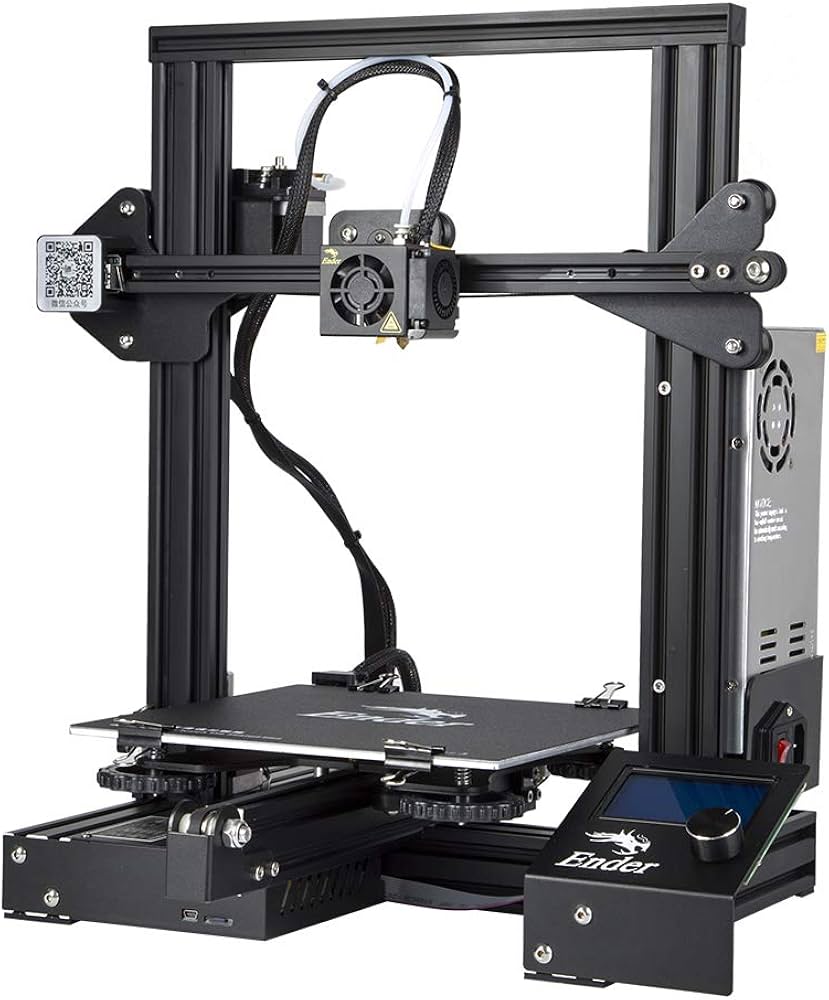The Ender 3 Pro 3D printer is a popular choice for beginners and hobbyists. It offers a great mix of features and value. This printer is easy to set up and use, making it perfect for those new to 3D printing.
The Ender 3 Pro uses fused deposition modeling (FDM) to create objects layer by layer. It has a build volume of 220 x 220 x 250 mm, which is big enough for most projects. The printer comes with a magnetic build plate that makes removing prints simple.
Users can expect good print quality from the Ender 3 Pro. It has a sturdy frame that helps reduce vibrations during printing. The printer also comes with a UL certified power supply for added safety. With some practice, even new users can create detailed models and functional parts.
Ender 3 Pro: A Budget-Friendly 3D Printing Powerhouse
The Creality Ender 3 Pro is a popular choice for beginners and hobbyists looking to enter the world of 3D printing. It offers a great balance of affordability, features, and print quality, making it a strong contender in the budget 3D printer market.
Key Features
- Build Volume: 220 x 220 x 250 mm – Provides ample space for a variety of prints.
- Magnetic Build Plate: The removable magnetic bed makes it easy to remove prints.
- Upgraded Extruder: The MK-10 extruder reduces the risk of clogging and uneven extrusion.
- Sturdy Frame: The Y-axis has been redesigned with a 40×40 aluminum extrusion for increased stability.
- MeanWell Power Supply: Offers reliable power and faster heating.
- Open-Source Firmware: Allows for customization and community support.
Pros
- Affordable: One of the most budget-friendly 3D printers with decent quality.
- Good Print Quality: Capable of producing detailed and accurate prints.
- Easy to Assemble: The assembly process is relatively straightforward, even for beginners.
- Large Community Support: A large and active community provides resources, modifications, and troubleshooting assistance.
- Wide Range of Filaments: Compatible with various filament types, including PLA, ABS, PETG, and TPU.
Cons
- Manual Bed Leveling: Requires manual bed leveling, which can be time-consuming for beginners.
- Noise Level: Can be a bit noisy during operation.
- Basic User Interface: The user interface is functional but could be more user-friendly.
Is the Ender 3 Pro Right for You?
The Ender 3 Pro is an excellent choice for:
- Beginners: Its affordability and ease of assembly make it a great entry point into 3D printing.
- Hobbyists: Provides good print quality and versatility for various projects.
- Makers and Tinkerers: Open-source firmware allows for customization and experimentation.
Tips for Ender 3 Pro Users
- Bed Leveling: Mastering bed leveling is crucial for successful prints. Watch tutorials and practice to achieve a level bed.
- Firmware Updates: Consider updating the firmware to the latest version for improved performance and features.
- Community Resources: Utilize the vast online community for troubleshooting, modifications, and inspiration.
- Filament Quality: Use high-quality filament for optimal print results.
The Ender 3 Pro remains a popular and highly-regarded 3D printer, offering a compelling combination of affordability and performance. With a bit of practice and patience, you can achieve impressive results with this capable machine.
Key Takeaways
- The Ender 3 Pro is user-friendly and suitable for beginners
- It offers a good balance of features and affordability
- Regular maintenance helps ensure consistent print quality
Technical Specifications and Setup
The Ender 3 Pro 3D printer offers a range of features and specs. It requires some assembly and careful bed leveling for optimal performance.
Printer Specifications
The Ender 3 Pro uses Fused Deposition Modeling (FDM) technology. It has a build volume of 220 x 220 x 250 mm. The printer comes with a MeanWell power supply that is UL certified for safety.
Key specs include:
- Layer height: 0.1-0.4 mm
- Nozzle diameter: 0.4 mm
- Print speed: Up to 180 mm/s
- Filament diameter: 1.75 mm
- Supported materials: PLA, ABS, PETG
The magnetic build plate allows for easy print removal. A 32-bit silent mainboard reduces noise during printing.
Assembly and Bed Leveling
The Ender 3 Pro ships partially assembled. Final setup takes about 1-2 hours. The user manual provides step-by-step instructions.
Key assembly steps:
- Attach the vertical frame pieces
- Mount the print head and extruder
- Install the build plate
- Connect electronics and power supply
Proper bed leveling is critical for print quality. The printer has four adjustment knobs under the build plate. Users should level the bed before each print. A piece of paper can be used to set the correct nozzle height at each corner.
Operation and Maintenance
The Ender 3 Pro 3D printer needs proper setup and care for the best results. Regular upkeep helps avoid issues and keeps prints coming out great.
Getting Started with Your First Print
Set up the printer on a stable surface. Level the print bed using the four corners. Load filament into the extruder. Check that the nozzle is clean and not clogged.
Choose a simple test model to start. Slice the 3D file using Cura or another slicer program. Save the G-code to the SD card. Insert the card and select the file on the printer’s screen.
Watch the first layer go down. Make sure it sticks well to the bed. If needed, adjust the bed level or change settings like temperature.
Upkeep and Troubleshooting
Clean the print bed after each print. Use rubbing alcohol on a cloth. Remove any plastic bits stuck to the nozzle.
Check belts and wheels for tightness monthly. Tighten loose belts. Clean dust off rails and wheels.
If prints fail, check for clogs in the nozzle. Heat it up and push filament through by hand. Use the needle tool to clear stubborn clogs.
Prints not sticking? Re-level the bed. Clean it well. Try glue stick or painter’s tape for better adhesion.
Extending Capabilities
Add a glass bed for smoother prints. Install a BLTouch sensor for auto bed leveling.
Try different nozzle sizes. A smaller nozzle gives finer details. A larger one prints faster.
Upgrade the mainboard for quieter printing. Add OctoPrint on a Raspberry Pi to control the printer remotely.
Experiment with different filaments. PLA is easy to start. PETG is stronger. TPU makes flexible parts.
Frequently Asked Questions
The Ender 3 Pro 3D printer has many features that users often ask about. Here are answers to some common questions about this popular 3D printer model.
What are the build volume dimensions of the Ender 3 Pro?
The Ender 3 Pro has a build volume of 220 x 220 x 250 mm. This size allows for printing many small to medium-sized objects. The printer can make items up to about 8.6 inches wide, 8.6 inches deep, and 9.8 inches tall.
How does the Ender 3 Pro differ from the Ender 3 V2?
The Ender 3 Pro and V2 have some key differences. The V2 has a color screen, while the Pro has a basic LCD screen. The V2 also has a quieter motherboard and better cooling. The Pro has a magnetic print bed, but the V2 has a glass bed.
Can you recommend any improvements or upgrades for the Ender 3 Pro?
Some helpful upgrades for the Ender 3 Pro include:
- A glass print bed for better adhesion
- An all-metal extruder for more reliable feeding
- Upgraded cooling fans for better print quality
- A BLTouch sensor for auto bed leveling
These changes can improve print results and make the printer easier to use.
What materials can be printed with the Ender 3 Pro?
The Ender 3 Pro can print many materials. Common options include:
- PLA plastic
- ABS plastic
- PETG plastic
- TPU flexible filament
With some upgrades, it may also print wood-filled or metal-filled filaments. The stock printer works best with PLA.
What is the typical lifespan of the Ender 3 Pro’s components?
The lifespan of Ender 3 Pro parts varies. With proper care:
- The control board can last 3-5 years
- Belts may need replacing every 1-2 years
- The nozzle should be changed after 3-6 months of heavy use
- Fans often last 1-2 years before needing replacement
Regular cleaning and maintenance help parts last longer.
What troubleshooting steps are suggested for common printing issues with the Ender 3 Pro?
For common issues:
- Check bed leveling if prints don’t stick
- Clean the nozzle if it clogs
- Adjust print temperature for stringing or poor layer adhesion
- Tighten belts if prints have shifted layers
- Check filament quality and dryness for inconsistent extrusion
Many problems can be fixed by checking these basic factors first.







